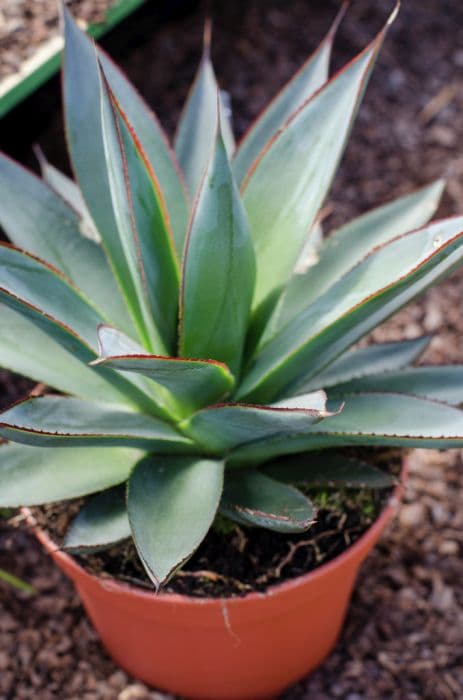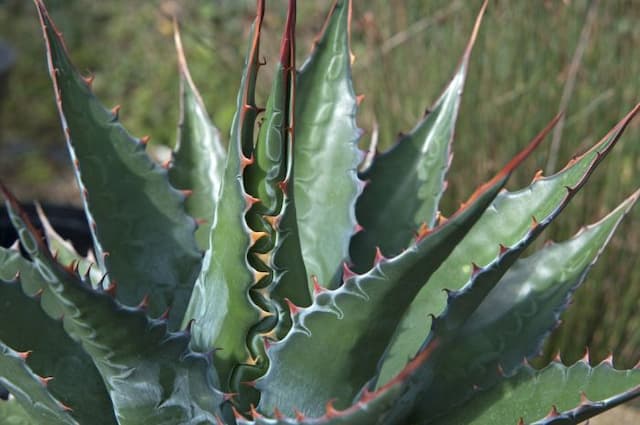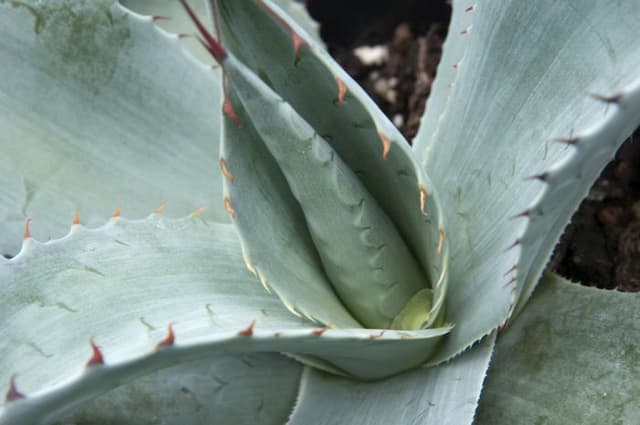Forest Lily Veltheimia capensis

ABOUT
Veltheimia capensis, commonly known as forest lily, is an eye-catching bulbous plant that boasts a distinctive appearance. The plant produces a rosette of broad, glossy green leaves which are wavy or undulating at the edges, contributing to its lush, ornamental quality. These leaves typically showcase a fleshy texture, often cradling the plant's striking inflorescence. The most remarkable feature of the forest lily is its bloom. The flowering stem is topped with a dense cluster of tubular flowers, which blossom in a multitude of shades ranging from pink to red, occasionally with accents of yellow or green at the base. These flowers are arranged in a sort of conical or cylindrical shape, creating a showy and colorful display that stands out among the glossy foliage. The overall appearance of Veltheimia capensis is one of vibrant color and rich, green textures, with the glossy leaves forming an attractive groundcover from which the floral display arises with grace and beauty. The plant captures attention when in bloom and adds a touch of exotic elegance to any setting where it is grown.
About this plant
 Names
NamesFamily
Asparagaceae
Synonyms
Forest Lily, Winter Red Hot Poker, Cape Lily, Sand Onion
Common names
Veltheimia glauca, Veltheimia viridifolia, Veltheimia undulata.
 Toxicity
ToxicityTo humans
The Veltheimia capensis, commonly known as the Forest Lily or Cape Lily, is not widely reported to be toxic to humans. However, precaution should be taken as with all plants not typically meant for consumption, particularly since closely related plant species may contain toxic compounds. If a person ingests a part of the Forest Lily, and experiences symptoms such as nausea, vomiting, diarrhea, or any other concerning reactions, they should seek medical attention, as individual sensitivities to plant substances can vary.
To pets
The Forest Lily, or Veltheimia capensis, does not have a known significant toxicity to pets like dogs and cats. In general, non-toxic plants can sometimes cause mild gastrointestinal upset if ingested by pets due to the irritation of the stomach or intestines. If a pet consumes parts of the Forest Lily, they may experience minor symptoms such as drooling, vomiting, or diarrhea. Should your pet display symptoms after ingestion, or if you suspect they have ingested a considerable amount of the plant, it is advisable to contact a veterinarian.
 Characteristics
CharacteristicsLife cycle
Perennials
Foliage type
Deciduous
Color of leaves
Varies
Flower color
Pink
Height
1-2 feet (30-60 cm)
Spread
1 foot (30 cm)
Plant type
Bulb
Hardiness zones
9
Native area
South Africa
Benefits
 General Benefits
General Benefits- Ornamental Value: Veltheimia capensis, also known as Forest Lily, has attractive foliage and colorful blooms that enhance the aesthetic appeal of gardens and interior spaces.
- Low Maintenance: Forest Lily is known for being hardy and requiring minimal care, making it suitable for gardeners of all skill levels.
- Drought Tolerance: This plant can survive periods of low water availability, making it ideal for drought-prone areas or for water-wise gardening.
- Seasonal Interest: With its winter to spring blooming season, Veltheimia capensis provides color and interest during times when many other plants are not flowering.
- Attracts Pollinators: The bright blooms of the Forest Lily attract bees and other pollinators, supporting local ecosystems and biodiversity.
 Medical Properties
Medical PropertiesThis plant is not used for medical purposes.
 Air-purifying Qualities
Air-purifying QualitiesThis plant is not specifically known for air purifying qualities.
 Other Uses
Other Uses- Veltheimia capensis, commonly known as the Forest Lily, can be used in water-wise gardens in regions with similar climates to its native habitat, as it is tolerant of drought once established.
- The nectar of the Forest Lily's flowers may attract pollinators such as bees and butterflies, contributing to the biodiversity of the garden.
- With its striking appearance, Forest Lily bulbs can be gifted as ornamental plants to gardening enthusiasts who appreciate unique and exotic species.
- The leaves of Veltheimia capensis can be used in floral arrangements to provide a lush, green backdrop for other flowers, due to their glossy and textured appearance.
- Due to its love of partial shade, the Forest Lily can be planted under deciduous trees, providing a splash of color in the understorey before the tree leaves fully emerge.
- In frost-free areas, Veltheimia capensis can be used to create a perennial border that will return year after year, providing long-term landscaping solutions.
- The leaves of Forest Lily can also be a visual indicator of the changing seasons in a garden, as they die back in the summer to signal a period of dormancy.
- When grown in containers, Forest Lily can easily be moved to protect it from extreme weather conditions or to rearrange a patio's plant display for aesthetic purposes.
- Veltheimia capensis can be part of educational gardens or botanical collections where the aim is to showcase bulbous plants from different regions of the world.
- As a soil indicator plant, the presence of the Forest Lily can suggest well-drained, sandy, and loamy soil conditions, which can be informative for gardeners assessing their soil type.
Interesting Facts
 Feng Shui
Feng ShuiThe Forest Lily is not used in Feng Shui practice.
 Zodiac Sign Compitability
Zodiac Sign CompitabilityThe Forest Lily is not used in astrology practice.
 Plant Symbolism
Plant Symbolism- Resilience - Veltheimia capensis, commonly known as the forest lily, has a bulbous base that allows it to survive through harsh conditions by going dormant, symbolizing the ability to withstand challenges.
- Beauty and Grace - The forest lily's striking flowers, which bloom atop a tall stem, represent natural elegance and the capacity to rise with poise above the undergrowth of life's complexities.
- Renewal and Hope - As a plant that emerges with vibrant blooms, the forest lily signifies the start of a new cycle, offering hope for fresh beginnings.
 Water
WaterThe forest lily should be watered thoroughly, allowing the top inch of soil to dry out before the next watering. This usually means watering about once a week, but the exact frequency depends on environmental conditions such as temperature and humidity. Provide about 16-24 ounces of water for an average-sized pot each time you water. During its dormant period, after the leaves yellow, reduce watering significantly, providing just enough to keep the bulb from drying out entirely.
 Light
LightThe forest lily thrives best in bright, indirect light. It should be placed in a spot where it can receive filtered sunlight or partial shade, as direct sunlight can scorch its leaves. An east or north-facing window is often ideal, offering the soft light preferred by this plant.
 Temperature
TemperatureThe forest lily does well in average room temperatures, ideally between 60-75 degrees Fahrenheit. It can tolerate a minimum of 50 degrees Fahrenheit and a maximum of around 80 degrees Fahrenheit. Avoid placing the plant in drafts or near heating and air conditioning vents that could cause sudden temperature changes.
 Pruning
PruningPruning of the forest lily is generally done to remove spent flowers and yellowing leaves to encourage new growth and maintain an attractive appearance. It’s best to prune after the blooming period is over, usually in late spring or early summer. Cut off the flower stalks at the base and any dead foliage, but be careful not to damage the bulb.
 Cleaning
CleaningAs needed
 Soil
SoilForest lily prefers well-draining soil with a mixture of potting soil, peat, and perlite or sand, with an ideal pH of 6.0 to 7.0 for optimal growth.
 Repotting
RepottingForest lily should be repotted every 2 to 3 years or when it outgrows its current pot to ensure continued health and space for growth.
 Humidity & Misting
Humidity & MistingForest lily thrives best in moderate to high humidity levels, ideally between 40% and 70%.
 Suitable locations
Suitable locationsIndoor
Place Forest lily in bright, indirect light with good air circulation.
Outdoor
Plant Forest lily in dappled shade and protect from harsh sun.
Hardiness zone
9-11 USDA
 Life cycle
Life cycleVeltheimia capensis, commonly known as the Forest Lilly, begins its life cycle as a bulb, which after a period of dormancy, will sprout leaves. These strap-shaped leaves grow rapidly, forming a rosette at the base of the plant. Following the leafy stage, a tall flower spike emerges, bearing showpiece blooms that are usually pink or red, which can attract pollinators and lasts for several weeks. After flowering, the plant sets seed, which if distributed can give rise to new bulbs elsewhere. Once the flowering and seeding are complete, the plant enters a dormant phase where the leaves die back, and the bulb rests, often during the dry or hot season. The cycle restarts with the next favorable growth season when the bulb sends up new leaves and the process begins anew.
 Propogation
PropogationPropogation time
Late summer to autumn
Propogation: Veltheimia capensis, commonly known as forest lily, is most effectively propagated through the division of its bulbs. This is usually done at the end of the dormant period, just before the new growth begins, which typically occurs in late summer or early fall. During this process, offsets that have formed at the base of the parent plant are carefully separated. These offsets, which are miniature bulbs, should have some roots attached. They are then planted in well-draining soil at a depth about three times the height of the bulb, roughly 2 to 3 inches (5 to 7.5 cm). The young bulbs will establish themselves and produce new shoots in the following growing season, thus giving rise to new forest lily plants.









